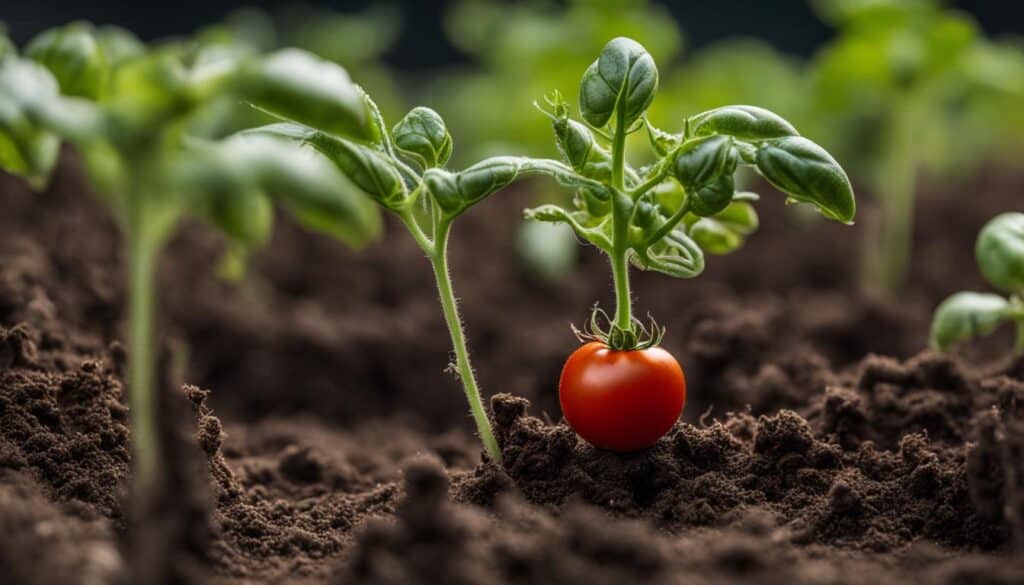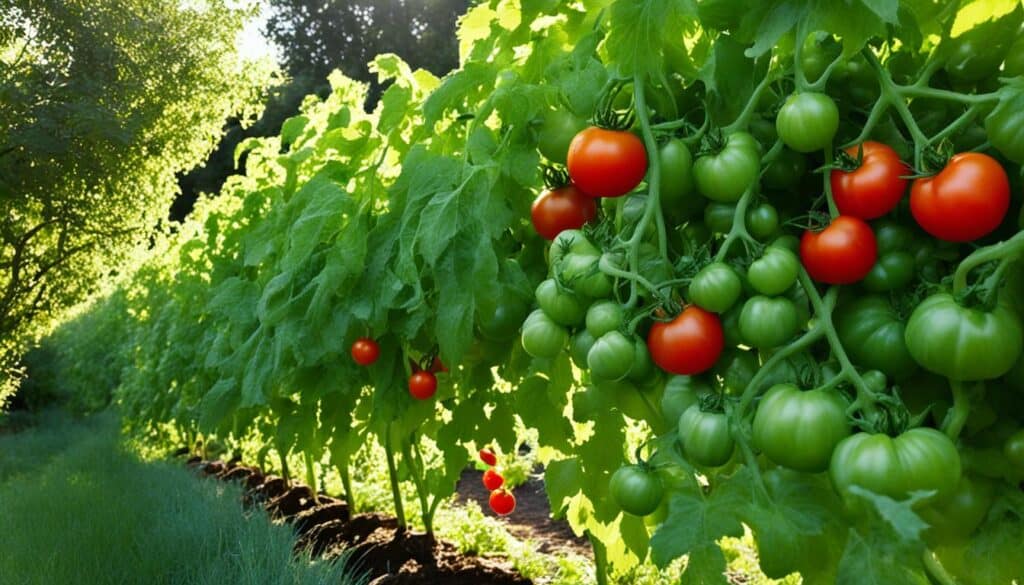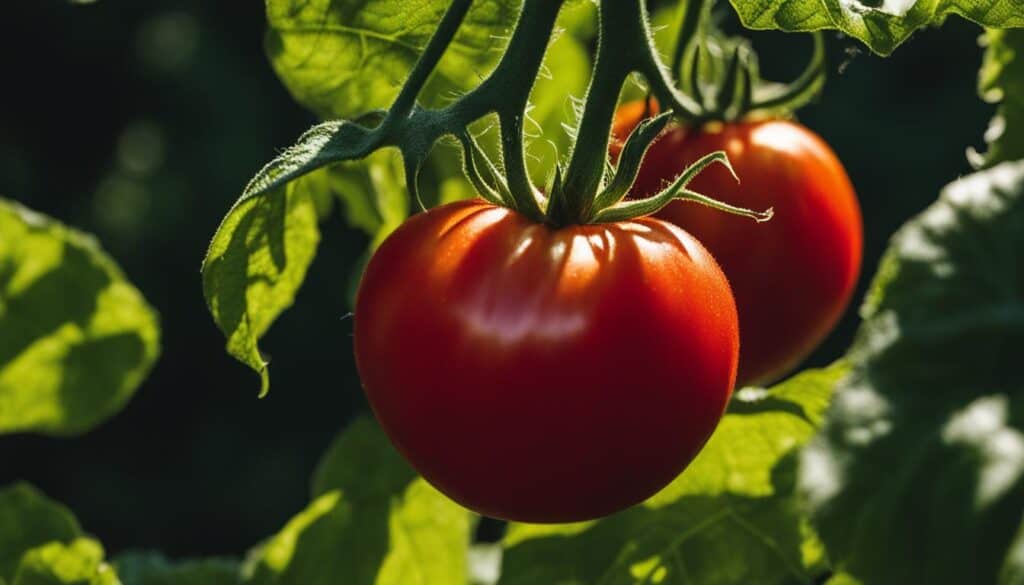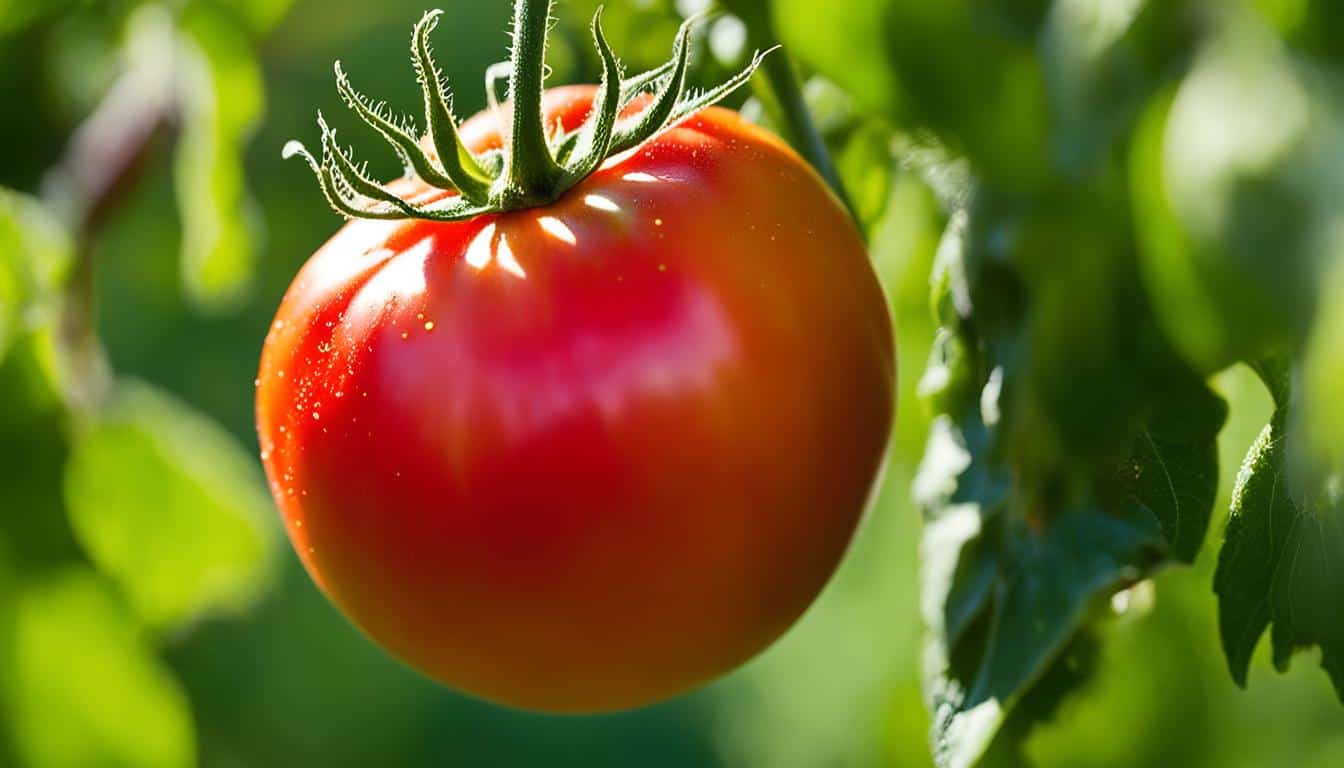Did you know that Brandywine tomatoes are considered one of the best tomatoes to grow? These juicy and flavorful heirloom tomatoes have captured the hearts and taste buds of tomato enthusiasts around the world. With their reputation for exceptional taste and their unique characteristics, it’s no wonder that Brandywine tomatoes have become a must-have for tomato gardeners.
If you’re ready to take your tomato gardening to the next level and savor the deliciousness of homegrown Brandywine tomatoes, you’re in the right place. In this article, I will share with you all the tips and tricks you need to know to successfully cultivate these delectable tomatoes. From starting them indoors to managing pests and diseases, I’ll guide you step by step on your journey to growing the best Brandywine tomatoes.
Key Takeaways:
- Brandywine tomatoes are highly regarded as one of the best varieties to grow.
- These heirloom tomatoes are known for their exceptional taste and unique characteristics.
- In this article, I will share valuable tips and tricks for successfully growing Brandywine tomatoes.
- Learn how to start Brandywine tomatoes indoors, provide the right growing conditions, and manage pests and diseases.
- With the right care and attention, you can enjoy the juicy and flavorful fruits of your labor.
What Are ‘Brandywine’ Tomatoes?
‘Brandywine’ tomatoes are an heirloom cultivar known for their large, beefsteak-type fruits. They can be red, pink, or yellow in color and have a ridged and asymmetrical shape. The plants have tall vines and unique foliage. They take 80 to 100 days to produce fruit and have an indeterminate growth habit, meaning they will continue to bloom and produce fruit as long as conditions are favorable.
Brandywine tomatoes with their unique colors and characteristic shape.
If you’re a tomato enthusiast, you’ve likely come across the name ‘Brandywine’ when exploring different tomato varieties. These heirloom tomatoes have gained popularity for their exceptional taste, size, and distinct characteristics. Whether you’re a seasoned gardener or just starting out, understanding the key features and growing habits of ‘Brandywine’ tomatoes can help you make the most of your tomato garden.
Cultivation and History
When it comes to growing tomatoes, few varieties can match the popularity and rich heritage of ‘Brandywine’ tomatoes. These heirloom tomatoes have been cultivated for over a century, making them one of the oldest heirloom varieties available commercially. Although the exact origins of ‘Brandywine’ tomatoes are uncertain, they have been listed in seed catalogs since the late 1800s, capturing the hearts of gardeners for generations.
The fascinating history of ‘Brandywine’ tomatoes is intertwined with the passion of dedicated gardeners who have saved seeds over the years. This practice has led to the emergence of various substrains carrying the name ‘Brandywine’. Despite the uncertain historical records, ‘Brandywine’ tomatoes continue to be cherished and sought after by tomato enthusiasts for their exceptional flavor and unique characteristics.
| Key Information | Cultivation and History |
|---|---|
| Popular Variety | ‘Brandywine’ tomatoes |
| Heritage | Heirloom tomatoes with a rich history |
| Growth Duration | Over a century |
| Availability | Commercially available since the late 1800s |
| Gardener Influence | Seed saving resulting in various substrains |
| Continued Popularity | Remains one of the most popular homegrown varieties |
Despite the passage of time and the introduction of new tomato varieties, ‘Brandywine’ tomatoes have stood the test of time. Cultivating these tomatoes allows gardeners to connect with a bygone era and preserve the legacy of heirloom tomatoes for future generations.
Propagation

When it comes to propagating ‘Brandywine’ tomatoes, starting from seeds is the way to go. The process is simple and rewarding, allowing you to nurture these delicious fruits from the very beginning.
Indoor Sowing
To get started, sow your ‘Brandywine’ tomato seeds indoors a couple of months before the last frost. Choose quality seeds from a reputable source to ensure the best results. Fill seed trays or pots with warm and moist soil, then plant the seeds at a depth of 1/4 to 1/2 inch.
Place the trays or pots in a warm and well-lit area, such as a bright window or a warm greenhouse. ‘Brandywine’ tomatoes thrive in sunlight, so choose a spot that receives ample light throughout the day. Ensure the soil remains consistently moist but never waterlogged.
Transplanting Seedlings
After the seedlings have germinated and grown their first set of true leaves, they are ready to be transplanted. This usually takes around 6 to 8 weeks.
Prior to transplanting, harden off the seedlings by gradually acclimating them to outdoor conditions. Start by placing them outside for a few hours each day, gradually increasing the duration over the course of a week.
Choose a sunny spot in your garden with well-drained and fertile soil. ‘Brandywine’ tomatoes thrive in nutrient-rich soil, so consider amending it with organic matter or compost before planting.
Prepare the planting holes, ensuring they are deep enough to bury the seedlings up to their first set of leaves. Pinch off the bottom leaves, leaving only the top leaves above the soil surface.
Place each seedling in its planting hole, gently covering the roots with soil. Firmly press the soil around the seedling to provide stability and good contact between the roots and the soil.
Watering and Support
Once the ‘Brandywine’ tomato plants are in the ground, water them regularly to keep the soil evenly moist. Aim to provide about one inch of water per week, adjusting based on the weather conditions.
As the plants grow, they will develop tall vines that require support. Consider using stakes, trellises, or cages to provide vertical support for the vigorous growth. This helps prevent the vines from sprawling on the ground, reduces the risk of disease, and ensures good airflow around the plants.
With proper care and attention, your ‘Brandywine’ tomato plants will flourish and reward you with an abundant harvest of juicy and flavorful fruits.
How to Grow

To grow ‘Brandywine’ tomatoes successfully, it’s important to provide them with the right growing conditions. Follow these tips to help your tomato plants thrive:
Choose the Right Location
Find a sunny spot in your garden with well-draining soil. ‘Brandywine’ tomatoes prefer at least 8 hours of direct sunlight each day. Ensure the soil is fertile and enriched with organic matter.
Planting and Support
When planting your ‘Brandywine’ tomato seedlings, space them adequately to allow for proper air circulation. These plants can grow quite tall, so provide sturdy support, such as trellises or cages, to prevent them from sprawling on the ground.
Tip: Mulching around the base of the plants with organic materials can help regulate soil moisture and temperature while reducing weed growth.
Watering and Fertilizing
Water your ‘Brandywine’ tomatoes regularly to keep the soil consistently moist. Aim for about an inch of water per week, either from rain or irrigation. Fertilize the plants with organic matter or a balanced fertilizer to provide the necessary nutrients for healthy growth.
Pruning and Disease Prevention
Prune your ‘Brandywine’ tomato plants to improve airflow and remove any leaves that touch the ground. This helps prevent diseases that can spread through soil contact. Watch out for common tomato pests and diseases, such as aphids, hornworms, and fungal infections, and take appropriate measures to manage them.
Harvesting
When your ‘Brandywine’ tomatoes are fully ripened, usually around 80 to 100 days after planting, harvest them by gently twisting the fruits to detach them from the vines. Enjoy the delicious taste of these flavorful heirloom tomatoes as fresh ingredients in your favorite recipes.
Growing Tips
When it comes to growing ‘Brandywine’ tomatoes, following some essential tips can help you achieve a successful harvest. Whether you are a beginner or an experienced gardener, these tips will guide you through the process and ensure your tomato plants thrive.
Starting Indoors Before the Last Frost
To get a head start on the growing season, it is recommended to start your ‘Brandywine’ tomato seeds indoors before the last frost. This allows the seedlings to develop strong roots and sturdy stems before being transplanted into the garden. You can use seed trays or pots filled with seed-starting mix and place them in a warm and well-lit area.
Hardening Off Seedlings
Prior to transplanting your ‘Brandywine’ tomato seedlings outdoors, it is essential to harden them off. This means gradually exposing the seedlings to outdoor conditions, such as sunlight, wind, and fluctuating temperatures. Start by placing them outside for a few hours each day and gradually increase the time over a week or two. This process helps the seedlings adjust to the outdoor environment and reduces the risk of transplant shock.
Planting in Well-Drained and Fertile Soil
‘Brandywine’ tomatoes thrive in well-drained and fertile soil. Prepare your garden bed by loosening the soil and incorporating organic matter, such as compost or aged manure, to improve its fertility and drainage. Choose a sunny location with at least 8 hours of direct sunlight for optimal growth and fruit production.
Providing Support for Tall Vines
Due to their indeterminate growth habit, ‘Brandywine’ tomato plants can become quite tall and vigorous. To support the heavy vines and prevent them from sprawling on the ground, use stakes, cages, or trellises. These structures provide stability and help maximize airflow around the plants, reducing the risk of diseases.
Regular Watering and Fertilizing
Consistent watering is crucial for healthy ‘Brandywine’ tomato plants. Aim to provide about 1-1.5 inches of water per week, either through rainfall or irrigation. To ensure even moisture levels, consider using a soaker hose or drip irrigation system. Additionally, fertilize the plants regularly with a balanced tomato fertilizer according to the package instructions. This will provide the necessary nutrients for strong growth and abundant fruiting.
Pruning and Maintenance
Proper pruning and maintenance are essential for ‘Brandywine’ tomato plants. Remove the suckers, which are the small shoots that form in the leaf axils, to direct the plant’s energy towards fruit production. Additionally, prune any foliage touching the ground to prevent the spread of diseases. Regularly inspect the plants for pests and diseases, and take appropriate measures to manage them.
Harvesting Ripe Fruit
Knowing when to harvest your ‘Brandywine’ tomatoes is crucial for enjoying their delicious flavor. The ripe fruits should be firm but give slightly when gently squeezed. They should have vibrant colors, depending on the specific variety you are growing. Harvesting the fruit at the right time ensures optimal taste and texture.
| Growing Tips | |
|---|---|
| Start indoors before the last frost | Brandywine tomato |
| Harden off seedlings before transplanting | Tomato plants |
| Plant in well-drained and fertile soil | Tomato gardening |
| Provide support for tall vines | Best tomatoes to grow |
| Regularly water and fertilize | Tomato cultivation |
Where to Buy

Looking to get your hands on some ‘Brandywine’ tomato seeds? Look no further! Here are a few trusted seed catalogs where you can find a variety of ‘Brandywine’ tomato seeds:
- True Leaf Market: Offering a wide selection of ‘Brandywine’ tomato seeds, including red, pink, yellow, and black varieties.
- Eden Brothers: Explore their collection of ‘Brandywine’ tomato seeds and choose from different colors to suit your taste.
- Burpee: Known for their high-quality seeds, Burpee has ‘Brandywine’ tomato seeds available in various colors.
When purchasing ‘Brandywine’ tomato seeds, consider your preferences in terms of color and variety. Ensure that you choose a reputable source to ensure the quality of the seeds.
Managing Pests and Disease
‘Brandywine’ tomatoes, like other tomato plants, are vulnerable to a range of pests and diseases that can hinder their growth and affect fruit production. By understanding common tomato pests and diseases and implementing effective management strategies, you can protect your ‘Brandywine’ tomato plants and ensure a bountiful harvest.
Pests
Pests that commonly affect ‘Brandywine’ tomatoes include:
- Tomato hornworms: These large green caterpillars can quickly defoliate tomato plants. Handpicking or using natural predators like Braconid wasps can help control their population.
- Loopers: Loopers are caterpillars that eat tomato plant leaves. Apply organic insecticides or use row covers to prevent their damage.
- Beet armyworms: These pests are similar to tomato hornworms but smaller and more voracious. Monitor plants closely and use insecticides if necessary.
- Slugs: Slugs chew irregular holes in leaves and fruits. Remove hiding places like mulch and use slug traps or deterrents to protect your plants.
- Aphids: These small insects suck sap from plant tissues. Use insecticidal soap or predatory insects like ladybugs to control aphid populations.
Regularly inspect your tomato plants for signs of these pests, such as damaged leaves, chewed fruits, or the presence of insects. Taking immediate action will help prevent further damage and maintain healthy plant growth.
Diseases
Common tomato diseases that can affect ‘Brandywine’ tomatoes include:
- Early blight: This fungal disease causes dark spots on lower leaves, which eventually turn yellow and drop. Apply fungicides and practice proper cultural care to prevent its spread.
- Anthracnose: Anthracnose causes sunken lesions on tomatoes and can lead to rotting. Remove and destroy infected plant parts and use copper-based fungicides for control.
- Septoria leaf spot: This fungal disease causes small, brown spots with white centers on leaves. Remove infected leaves and use fungicides as necessary.
To manage tomato diseases, it is crucial to provide adequate airflow around plants by spacing them properly. Water at the base of the plants to avoid wetting the leaves. Practice crop rotation and avoid planting tomatoes in the same spot for consecutive years. Companion planting with marigolds or herbs like basil can also help deter pests and reduce disease incidence.
“Prevention is key when it comes to managing pests and diseases in ‘Brandywine’ tomatoes. Regularly monitor your plants, use best gardening practices, and take action at the first sign of trouble.” – Garden Expert
Conclusion
Growing ‘Brandywine’ tomatoes can be a rewarding experience. These heirloom plants produce juicy and flavorful fruits that will delight your taste buds. By providing them with the right care and attention, you can enjoy a bountiful harvest of these delicious tomatoes.
To start growing ‘Brandywine’ tomatoes, begin by planting the seeds indoors before the last frost. Once the seedlings have emerged, transfer them to a sunny location with rich, well-draining soil. Remember to provide support for the tall vines as they grow.
As your tomato plants develop, be diligent in managing pests and diseases. Regularly inspect the plants for any signs of trouble and take appropriate action. And finally, when your ‘Brandywine’ tomatoes ripen to perfection, pick them and savor their incredible taste.
Whether you are an experienced gardener or just starting out, ‘Brandywine’ tomatoes are a fantastic choice for your garden. So grab your gardening tools, get your hands dirty, and enjoy the satisfaction of growing your own delicious ‘Brandywine’ tomatoes!





Leave a Reply